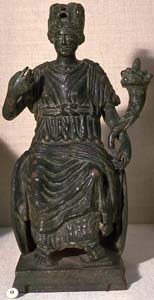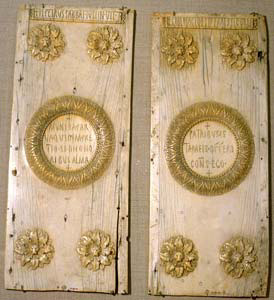 |
 |
 |
| Lecture 4. Threshold to the Middle Ages: East |
|
The key question for today--how does one thing "stand for" something else? There is obviously an amazing range of possibilities. The thing might actually look like the object depicted--a simulacrum. It may be a purely abstract sign--forming part of an encoded language familiar to makers and users. Some signs bear no resemblance to the thing they stand for. Others share some vital characteristic--for example the crucifix. And of course there is an infinite range of possibilities that determine how closely the sign or image should resemble the thing depicted. Our period was one where protocols were defined in an attempt to fix such questions and where intense debates took place concerning the appropriateness of the use of images in a religious context. The Jewish tradition was very negative toward the use of graven images--particularly images of God. In the context of early Christianity, however, there was an overlap between pagan and Christian imagery--an artist attempting to depict Christ might draw his inspiration from an image of Apollo. And antique art was rich in allusive imagery where, for example, a human form could "stand for" an emotion; a place or a time. Two objects can serve a focal points for our discussion -- the Tyche of Constantinople and the Consular Diptych of Justinian. Increasing internal instability in Rome coupled with external threats as well as the need for a new Christian capital led Constantine in 324-330 after defeat of Licinius, to transform Byzantium into Constanstantinople. Byzantium was a former Greek colony (Byzantion, from Megara) located on a peninsula between the Sea of Marmara and the Golden Horn in the Bospherus between the Black Sea and the Mediterranean. Constaninople was not necessarily intended to replace Rome -- it was only one-twentieth the size. The location was a cross-roads enjoying the advantage of a natural land route from Asia to Europe. The site was already an important Roman provincial city with an Acropolis, temples, aquaducts etc. A political precedent was established with Diocletian's creation of a west-east administrative division in 292, headed by the tetrarchs. In addition, Diocletian had emphasized provincial capitals, for example, Milan, Trier ,York and Antioch. Rome fell soon thereafter into the hands of the Ostrogoths and Constantinople continued as the capital of the eastern Roman Empire -- later to be known as the Byzantine Empire. A different flavor characterized the eastern provinces: the use of Greek; the existence of ancient Christian centers; heresy; contact with peoples who opposed the use of images. By the end of the 4th century, Constantinople was recognized as the "New Rome." The character of Constantinople emerged from such factors as the great palace placed close to hippodrome, the number of public buildings; fora, colonnades, honorific columns, arches, aquaducts, theatres, hippodrome. Yet, a pagan flavor of dedication ceremony and commemoration of Constantine as Sol invictus persisted. The Christian character of the city developed with the completion of two great churches: Hagia Sophia and new Holy Apostles under Constantius II (337-61). With the reign og Emperor Theodosius, Constantinople enjoyed an urban expansion including new fora and public baths as well as a new monastery of Saint John Stoudios. The population is estimated to have been between 300,000 and 600,000. The Reign of Justinian (527-565) Justinian I was of peasant origins. Brought to Constantinople by his uncle, the emperor Justin, who had risen to power through the army. He enjoyed an excellent education and succeeded his uncle in 532. At that time, Constantinople had a population of more than half a million -- much larger than Rome, Antioch or Alexandria. The Legislative Work of Justinian includes the publication of the Codex Justinianus (529) superceding all older codes. In 533, the Institutions provided a handbook for the use of students. In 534 the Novels -- published in Greek -- reflected the needs of contemporary life -- whereas the Codex and Institutions preserved Roman law. The church was divided by heresy concentrated on the nature of Christ. Justinian's reforms were aimed at unification and included reform acts for economic and legal issues as well as the reorganization of civil service. The Nika riot of 532 left tens of thousands of people dead and the civic center of the old town burned. In 542, bubonic plague killed half of the population. The city began to undergo a transformation from antique open spaces toward a more crowded medieval city. "Only those who have read widely and studied its origin and growth will really understand the authority and highest nature of the Roman Church. To sustain the faith of the unlettered masses there must be something that appeals to the eye, or it will wither away. But if authority were visibly displayed in magnificent buildings, imperishable monuments and everlasting witnesses seemingly built by God himself, the belief implanted by doctrine would be confirmed and strengthened....." (Nicolas V). In the west, Ravenna, a Roman city inland from the imperial port of Classis, assumed greater importance. In 402, the western emperor Honorius transferred his capital there -- protected by navy and ring of marshes. In 493, the city was conquered by Ostrogoths and served as Theoderic's capital until it was recaptured by Belisarius in 540. The principal architectural monuments of Ravenna and environs include: The Arian baptistery built the late fifth century by Theoderic S. Apollinare in Classe, founded by Bishop Ursicinus (534-6) with funds from a local banker, Julianus Argentarius, consacrated 549 by Bishop Maximian. S. Apollinare Nuovo, originally built as Theoderic's palace church and dedicated to the Saviour; rededicated to St. Martin of Tours and finally to St. Apollinaris in the ninth century after the transfer of relics. The mosaic decoration arranged in three tiers. Lowest with processions of male martyrs (south) advancing from the palace to Christ and female martyrs (north) advancing from Classis to the Virgin. These mosaics commissioned by Bishop Agnellus replacing images of Theoderic's court. The middle level includes Apostles and Prophets. At top cycle of images of Christ's ministry, Passion and Resurrection. S. Vitale. Vitalis was one of the seven sons of Felicity, all martyred under Antonius Pius; all buried in Rome. Begun by Bishop Ecclesius and financed by Julianus Argentarius who spent 26,000 solidi on its construction, the church was consecrated 547 by Bishop Maximinian. There is a Eucharistic theme in the mosaic decoration of the choir with Old Testament premonitions; the presence of Emperor Justinian and Empress Theodora and an eschatological apse image of Christ seated on a blue sphere flanked by 2 angels who present St Vitalis and Bishop Ecclesius. |



